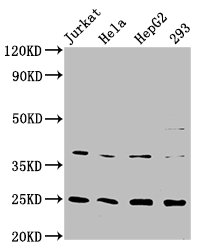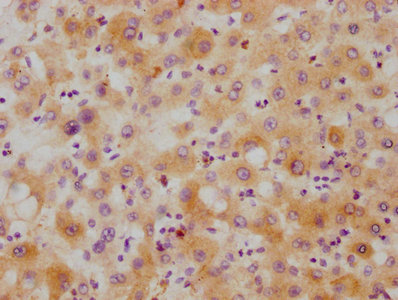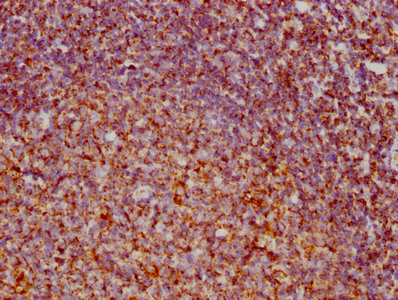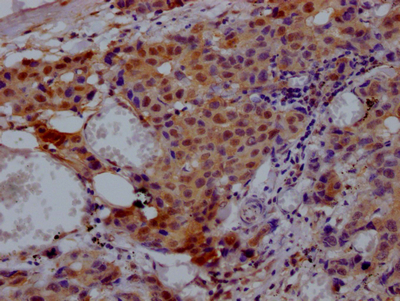HAMP Recombinant Monoclonal Antibody
-
货号:CSB-RA010124A0HU
-
规格:¥1320
-
图片:
-
Western Blot
Positive WB detected in: Jurkat whole cell lysate, Hela whole cell lysate, HepG2 whole cell lysate, 293 whole cell lysate
All lanes: HAMP antibody at 2.15μg/ml
Secondary
Goat polyclonal to rabbit IgG at 1/50000 dilution
Predicted band size: 10 KDa
Observed band size: 25 KDa -
IHC image of CSB-RA010124A0HU diluted at 1:215 and staining in paraffin-embedded human liver tissue performed on a Leica BondTM system. After dewaxing and hydration, antigen retrieval was mediated by high pressure in a citrate buffer (pH 6.0). Section was blocked with 10% normal goat serum 30min at RT. Then primary antibody (1% BSA) was incubated at 4℃ overnight. The primary is detected by a biotinylated secondary antibody and visualized using an HRP conjugated SP system.
-
-
其他:
产品详情
-
产品描述:
The recombinant HAMP antibody is a monoclonal antibody made in vitro using the HAMP antibody genes that are typically expressed from a plasmid in a stable mammalian cell line. The genes coding for the HAMP antibody will ultimately assemble into a fully functional antibody after translation. The synthesized antibody is the recombinant antibody against HAMP. It underwent purification using affinity-chromatography. This recombinant HAMP antibody is suitable for use in the ELISA, WB, IHC to detect the HAMP protein from Human.
HAMP is the encoding gene for hepcidin, a cysteine-containing cationic peptide primarily expressed in the liver, with a much lower extent of expression in the heart. It shows antimicrobial activity against gram-positive and gram-negative bacteria. Hepcidin blocks the release of iron from macrophages and intestinal cells, which is important for body iron metabolism. In humans, hepcidin regulates iron absorption into the bloodstream. Overproduction of hepcidin causes poor reticuloendothelial iron release and absorption, while deficient hepcidin synthesis causes iron loading.
-
Uniprot No.:P81172
-
基因名:HAMP
-
别名:Hamp antibody; HEPC antibody; HEPC_HUMAN antibody; Hepc20 antibody; Hepc25 antibody; HEPCIDIN antibody; Hepcidin 20 antibody; Hepcidin 25 antibody; Hepcidin antimicrobial peptide antibody; Hepcidin-20 antibody; Hepcidin25 antibody; HFE2 antibody; HFE2B antibody; LEAP 1 antibody; LEAP-1 antibody; LEAP1 antibody; Liver expressed antimicrobial peptide antibody; Liver-expressed antimicrobial peptide 1 antibody; PLTR antibody; Putative liver tumor regressor antibody
-
反应种属:Human
-
免疫原:Recombinant protein of Human HAMP
-
免疫原种属:Homo sapiens (Human)
-
标记方式:Non-conjugated
-
克隆类型:Monoclonal
-
抗体亚型:Rabbit IgG
-
纯化方式:Affinity-chromatography
-
克隆号:4C5
-
浓度:It differs from different batches. Please contact us to confirm it.
-
保存缓冲液:Rabbit IgG in phosphate buffered saline , pH 7.4, 150mM NaCl, 0.02% sodium azide and 50% glycerol.
-
产品提供形式:Liquid
-
应用范围:ELISA, WB, IHC
-
推荐稀释比:
Application Recommended Dilution WB 1:500-1:5000 IHC 1:50-1:200 -
Protocols:
-
储存条件:Upon receipt, store at -20°C or -80°C. Avoid repeated freeze.
-
货期:Basically, we can dispatch the products out in 1-3 working days after receiving your orders. Delivery time maybe differs from different purchasing way or location, please kindly consult your local distributors for specific delivery time.
相关产品
靶点详情
-
功能:Liver-produced hormone that constitutes the main circulating regulator of iron absorption and distribution across tissues. Acts by promoting endocytosis and degradation of ferroportin/SLC40A1, leading to the retention of iron in iron-exporting cells and decreased flow of iron into plasma. Controls the major flows of iron into plasma: absorption of dietary iron in the intestine, recycling of iron by macrophages, which phagocytose old erythrocytes and other cells, and mobilization of stored iron from hepatocytes.; Has strong antimicrobial activity against E.coli ML35P N.cinerea and weaker against S.epidermidis, S.aureus and group b streptococcus bacteria. Active against the fungus C.albicans. No activity against P.aeruginosa.
-
基因功能参考文献:
- Hepcidin is lower in more severely anemic children with sickle cell disease independent of inflammation or markers of erythropoiesis. PMID: 30056060
- serum hepcidin level has a role in iron status in children with cystic fibrosis PMID: 30057485
- Athree-dimensional (3D) model of hepcidin-25 with bound copper(II) is presented. PMID: 30072660
- our data demonstrate that hypoxia strongly potentiates the peroxide-mediated induction of hepcidin via STAT3 signaling pathway. Moreover, oxidases such as NOX4 or artificially overexpressed urate oxidase (UOX) can induce hepcidin PMID: 29459227
- High hepcidin maternal serum levels could be an early marker of preeclampsia. PMID: 29523273
- Suggest IL-6 can induce hepcidin in systemic lupus erythematosus flares. PMID: 27416847
- Serum hepcidin was associated with more severe anemia in advanced CKD patients. PMID: 29227972
- Data suggest that magnitude of up-regulation of serum hepcidin levels in response to acute exercise in adults is dependent on pre-exercise iron nutritional status (ferritin levels) and on circulating pro-inflammatory cytokines (prominently interleukin-6). [REVIEW] PMID: 29443922
- The present study provides new evidence that ASP decreases hepcidin expression, which can reduce iron burden and inhibit tumor proliferation. These findings might aid ASP developed as a potential candidate for cancer treatment in patients with iron overload. PMID: 29843136
- Postexercise supplementation with protein and carbohydrate and vitamins D3 and K2 did not blunt the postexercise hepcidin response in highly trained athletes. PMID: 28605609
- A decrease in serum FGF23 and hepcidin levels was observed in chronic hemodialysis patients treated with lanthanum carbonate. PMID: 27928636
- These observations suggest correlations between serum hepcidin and progression of chronic HBV infection, and may shed a new light on the development of biomarkers for HBV-related disease surveillance. PMID: 27694815
- Increasing adiposity in the pediatric population is associated with increasing IL-6, which stimulates hepcidin synthesis, leading to functional iron deficiency due to inhibition of iron absorption and mobilization from iron stores. PMID: 28604755
- Suggest that pentoxifylline may be a clinically and biologically meaningful modulator of hepcidin-25 in dialysis of patients with ESA-hyporesponsive anaemia. PMID: 27171136
- Among low birth weight infants, gestational age, IL-6, erythropoietin, and soluble transferrin receptor were associated with Hep25 levels. Therefore, prematurity, inflammation, hypoxia, and erythropoietic activity may be important perinatal factors that affect hepcidin levels. PMID: 28601871
- genetic association studies in cohort of infants in Spain: Data suggest that serum hepcidin levels increase in infants during first year of life and are positively associated with iron status only in infants with wild-type HFE gene (not in infants with genetic polymorphisms C282Y, H63D, and S65C). (HFE, homeostatic iron regulator) PMID: 29404719
- Data suggest that circulating hepcidin levels (a biomarker for iron-deficiency anemia) may be regulated by dietary factors other than iron; here, one-time high-dose vitamin D3 reduces plasma hepcidin levels in adults one week post-dosing, without changes in plasma pro-inflammatory cytokine or ferritin concentrations. PMID: 27402475
- Hepcidin can very well be utilized as a potential prognostic marker to follow patients with breast cancer metastatic to bone. PMID: 28442512
- Data suggest that hematologic parameters in children consuming lacto-ovo vegetarian diets are comparable with those of control children, but ferritin levels are lower; inclusion of novel serum biomarkers, soluble transferrin receptor and hepcidin, in nutritional assessment can better detect subclinical iron deficiency in children following vegetarian diet. This study was conducted in Poland with children ages 4.5-9 years. PMID: 28342014
- results suggest that lower Hepcidin-25, as well as higher sTfR and sTfR/Hepcidin-25 ratio were significant predictors of favorable hemoglobin response within a month after IV administration of ferric carboxymaltose in patients with CKD PMID: 27282576
- unreported iron metabolism-related genes in non-classic hereditary hemochromatosis patients that were predicted to be potentially pathogenic were three novel mutations in TFR2 [two missense (p.Leu750Pro and p.Ala777Val) and one intronic splicing mutation (c.967-1G>C)], one missense mutation in HFE (p.Tyr230Cys), and one mutation in the 5'-UTR of HAMP gene (c.-25G>A) PMID: 27667161
- increased intracellular iron content in recombinant-TfR1 HepG2 cells did not increase hepcidin responses compared to wild-type cells, resembling hemochromatosis PMID: 27667164
- Review of the role of hepcidin in iron metabolism disorders. PMID: 28073521
- The bone morphogenetic protein (BMP) pathway regulates expression of hepcidin through transcriptional activation via BMP-responsive elements (REs) 1 and 2 on the promoter. A search for GC-rich sequences on the hepcidin promoter indicated 13 regions across the distal (A to F), middle (G to I), and proximal (J to M) areas. PMID: 29105755
- Of the non-HFE forms of iron overload, TFR2-, HFE2-, and HAMP-related forms are predicted to be rare, with pathogenic allele frequencies in the range of 0.00007 to 0.0005. Significantly, SLC40A1 variants that have been previously associated with autosomal-dominant ferroportin disease were identified in several populations (pathogenic allele frequency 0.0004), being most prevalent among Africans PMID: 26633544
- Data (including data from studies using knockout mice) suggest that MT2/TMPRSS6 suppresses hepcidin expression in hepatocytes independently of HJV; MT2/TMPRSS6 cleaves ALK2, ALK3, ACTRIIA, BMPR2, HFE, and, to a lesser extent, HJV and TFR2; thus, MT2/TMPRSS6 suppresses hepcidin expression by cleaving multiple components of the hepcidin induction pathway. (MT2/TMPRSS6 = matriptase-2; HJV = hemojuvelin) PMID: 28924039
- two unrelated hepatocellular carcinoma patients bore the HAMP:c.-153C>T mutation at the heterozygous state, which is associated with increased risk of iron overload and severe hemochromatosis PMID: 26474245
- Hepcidin-25 released from plaque macrophages and other cell surfaces contributed to the plaque instability by inducing endothelial cell death. PMID: 27855289
- Hepcidin plasma levels were increased in patients with early rheumatoid arthritis compared with healthy volunteers. PMID: 28482738
- study followed the dynamics of hepcidin-mediated ferroportin internalization; also showed that the novel p.D84E mutation, associated with the classical form of ferroportin disease, is both iron transport defective and hepcidin insensitive PMID: 28681497
- During regulation of hepcidin synthesis, multiple promoter elements in the HAMP gene respond to variable signaling pathways corresponding to different extracellular situations. PMID: 28501597
- Our findings indicate that the HAMP-P -582A>G polymorphism (rs10421768) is associated with susceptibility to extrapulmonary TB, but not pulmonary TB. CD14+ monocytes from individuals with the rs10421768 GG genotype secreted significantly less hepcidin in response to M. tuberculosis lipoarabinomannan compared with cells from individuals with either the AA or AG genotypes. PMID: 28530443
- Expression of Hepcidin and Ferroportin in the Placenta, and Ferritin and Transferrin Receptor 1 Levels in Maternal and Umbilical Cord Blood in Pregnant Women with and without Gestational Diabetes PMID: 27483296
- this study shows that hepcidin is involved in the pathogenesis of sepsis-induced acute kidney injury PMID: 27266727
- The hepcidin plays a role in the pathogenesis and progression of kidney injury via modulation of iron-mediated oxidant injury. PMID: 28302014
- The levels of hepcidin were higher, while those of iron, transferrin, and sTfR were lower in children with cardiometabolic risk factors. PMID: 27139516
- Main pathways of systemic and genetic regulation of hepcidin, as well as its influence on the disorders related to iron metabolism. Review. PMID: 28514781
- Data suggest hepcidin is the master regulator of systemic iron homeostasis; hepcidin levels are suppressed when erythropoiesis is stimulated; the erythroid-derived hormone erythroferrone appears to be a convincing candidate for link between increased erythropoiesis and hepcidin suppression. [REVIEW] PMID: 27146013
- Data suggest that proinflammatory cytokine interleukin-1beta (IL1B) up-regulates hepcidin expression in hepatocytes; inflammation induces IL1B production in Kupffer cells and hepatocytes; IL1B up-regulates CEBPD (CCAAT/enhancer binding protein delta) expression in hepatocytes; up-regulation of CEBPD expression up-regulates hepcidin transcription. PMID: 28438835
- modification of HS structure mediated by heparanase overexpression affects hepcidin expression and iron homeostasis PMID: 27711215
- Serum hepcidin levels increased in premenopausal women participating in brisk walking exercises. PMID: 28361576
- Gene-based meta-analyses revealed 19 genes that showed significant association with hepcidin. Our results suggest the absence of common SNVs and rare exonic SNVs explaining a large proportion of phenotypic variation in serum hepcidin PMID: 27846281
- hepcidin induction by endoplasmic reticulum stress involves the central SMAD1/5/8 pathway PMID: 27483343
- a selective splicing variant of hepcidin mRNA lacking exon 2 of HAMP gene, producing the transcript that encodes truncated peptide lacking 20 amino acids at the middle of preprohepcidin, was found in hepatocellular carcinoma cell lines PMID: 27264950
- Gastric H. pylori infection is a common cause of IDA of unknown origin in adult patients. Our results provide evidence indicating that hepcidin level decreases after successful H. pylori eradication with improvement in IDA. PMID: 26932797
- The data of in vitro and in vivo research evidenced on involvement of Hepc in formation of breast cancer cells malignant phenotype and their resistance to doxorubicin. PMID: 27356575
- Hepcidin was a more influential determinant of iron stores than blood loss and dietary factors combined, and increased hepcidin diminished the positive association between iron intake and iron stores. PMID: 27598194
- These results suggest that the ingestion of a high (compared to low) CHO diet over a seven-day training period is ineffective in attenuating post-exercise IL-6 and hepcidin responses. Such results may be due to the modest training load, the increased protein intake in the low-CHO trial, and a 48 h recovery period prior to sample collection on day 7, allowing a full recovery of muscle glycogen status between exercise sessi PMID: 27379793
- The NGAL/hepcidin ratio is more strongly associated with severe of acute kidney injury than the single biomarkers alone PMID: 25479470
- serum NGAL and hepcidin levels might be valuable for the evaluation of inflammation in chronic kidney disease, not related through iron metabolism PMID: 26627016
显示更多
收起更多
-
相关疾病:Hemochromatosis 2B (HFE2B)
-
亚细胞定位:Secreted.
-
蛋白家族:Hepcidin family
-
组织特异性:Highest expression in liver and to a lesser extent in heart and brain. Low levels in lung, tonsils, salivary gland, trachea, prostate gland, adrenal gland and thyroid gland. Secreted into the urine and blood. Expressed by hepatocytes.
-
数据库链接:
HGNC: 15598
OMIM: 606464
KEGG: hsa:57817
STRING: 9606.ENSP00000222304
UniGene: Hs.8821
Most popular with customers
-
-
YWHAB Recombinant Monoclonal Antibody
Applications: ELISA, WB, IF, FC
Species Reactivity: Human, Mouse, Rat
-
Phospho-YAP1 (S127) Recombinant Monoclonal Antibody
Applications: ELISA, WB, IHC
Species Reactivity: Human
-
-
-
-
VDAC1 Recombinant Monoclonal Antibody
Applications: ELISA, WB, IHC
Species Reactivity: Human, Mouse, Rat
-
VCP Recombinant Monoclonal Antibody
Applications: ELISA, WB, IHC, IF, IP
Species Reactivity: Human, Rat






















